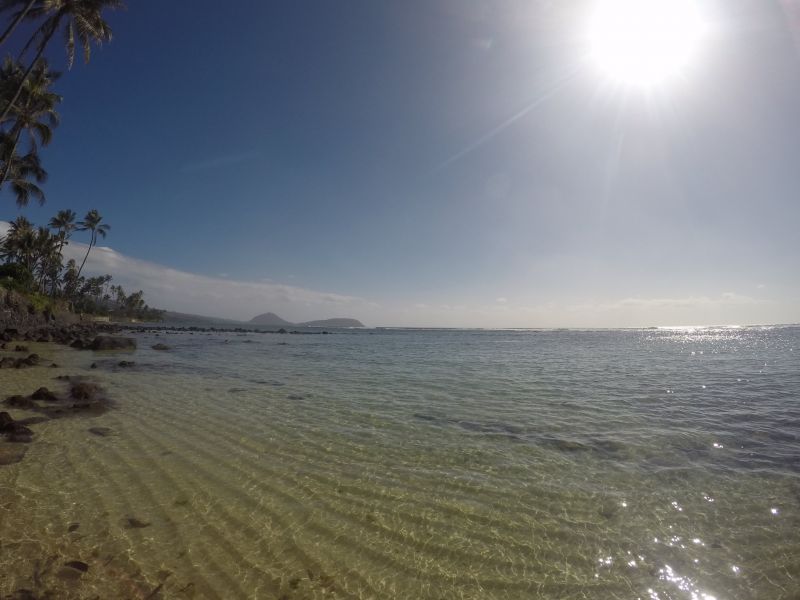New Research Shows How Submarine Groundwater Affects Coral Reef Growth
Published on by Water Network Research, Official research team of The Water Network in Academic
A recently published study, led by researchers at the University of Hawai'i at Mānoa's School of Ocean and Earth Science and Technology (SOEST), sheds light on the ways submarine groundwater discharge (SGD) affects coral reef growth.
Groundwater that seeps into the coastal zone beneath the ocean's surface—termed submarine groundwater discharge (SGD)—is an important source of fresh water and nutrients to nearshore coral reefs throughout the globe. Although submarine groundwater is natural, it can act as a conduit for highly polluted water to shorelines.

Maunalua Bay, Oahu, Hawaii. Credit: Florybeth La Valle, HIMB/ UH SOEST
A recently published study, led by researchers at the University of Hawai'i at Mānoa's School of Ocean and Earth Science and Technology (SOEST), sheds light on the ways SGD affects coral reef growth.
"SGD is common on nearshore coral reefs, especially in Hawai'i, so we set out to test how SGD affects coral reef growth in Maunalua Bay, O'ahu." said Megan Donahue, associate researcher at the Hawai'i Institute of Marine Biology (HIMB) in SOEST and senior author of the study.
Two processes contribute to the overall growth of coral reefs: coral growth and bioerosion, the natural breakdown of coral reefs by reef organisms. To determine how SGD affects these processes, the research team outplanted small pieces of lobe coral on the reef flat in areas with a range of SGD and measured the changes in size over a six-month period. They also put out blocks of dead coral skeleton across the same SGD gradients for one year to measure bioerosion rates. The blocks were scanned before and after the deployment with a micro-CT scanner, similar to a hospital CT scanner, to determine the amount of coral skeleton removed by bioeroding organisms in three dimensions.
In areas with high levels of SGD, it was a double whammy for coral reefs. Corals that were right next to SGD seeps performed poorly, likely due to the stress of too much fresh water.
"SGD is common on nearshore coral reefs, especially in Hawai'i, so we set out to test how SGD affects coral reef growth in Maunalua Bay, O'ahu." said Megan Donahue, associate researcher at the Hawai'i Institute of Marine Biology (HIMB) in SOEST and senior author of the study.
Two processes contribute to the overall growth of coral reefs: coral growth and bioerosion, the natural breakdown of coral reefs by reef organisms. To determine how SGD affects these processes, the research team outplanted small pieces of lobe coral on the reef flat in areas with a range of SGD and measured the changes in size over a six-month period.
They also put out blocks of dead coral skeleton across the same SGD gradients for one year to measure bioerosion rates. The blocks were scanned before and after the deployment with a micro-CT scanner, similar to a hospital CT scanner, to determine the amount of coral skeleton removed by bioeroding organisms in three dimensions.
In areas with high levels of SGD, it was a double whammy for coral reefs. Corals that were right next to SGD seeps performed poorly, likely due to the stress of too much fresh water.
"Additionally, we found that marine organisms responsible for bioerosion broke down the skeletal reef framework very quickly when exposed to high amounts of SGD," said lead author Katie Lubarsky, who completed this research as part of her graduate degree in Marine Biology at UH Mānoa.
"Many bioeroding organisms are filter feeders that perform better in high nutrient environments, so the high nutrient groundwater likely enhanced bioeroder activity. This indicates that high inputs of nutrient polluted SGD could favor reef breakdown and substantially slow down overall reef growth."
More information: Katie A. Lubarsky et al, Effects of submarine groundwater discharge on coral accretion and bioerosion on two shallow reef flats, Limnology and Oceanography (2018). DOI: 10.1002/lno.10799
Provided by: University of Hawaii at Manoa
Media
Taxonomy
- Ecosystem Management
- Groundwater
- Environment
- Ecosystem Management
- Pollution
- Groundwater Modeling
- Groundwater Pollution
- Groundwater Mapping